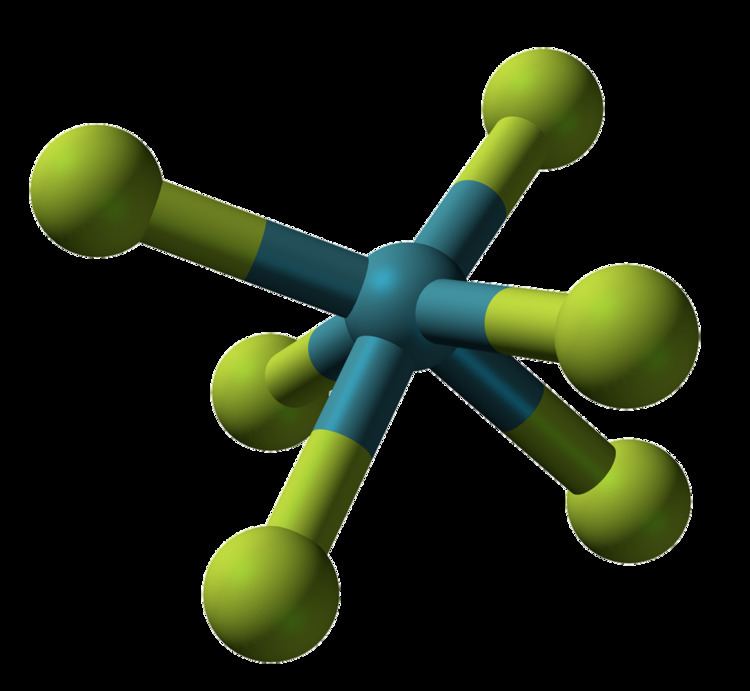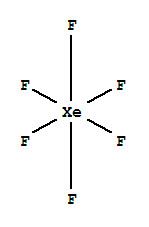Formula XeF6 Melting point 49.25 °C Boiling point 75.6 °C | Molar mass 245.28 g/mol Density 3.56 g/cm³ PubChem CID 139546 | |
 | ||
Xenon hexafluoride is a noble gas compound with the formula XeF6 and the highest of the three known binary fluorides of xenon, the other two being XeF2 and XeF4. All known are exergonic and stable at normal temperatures. XeF6 is the strongest fluorinating agent of the series. At room temperature, it is a colorless solid that readily sublimes into intensely yellow vapors.
Contents

Preparation

Xenon hexafluoride can be prepared by long-term heating of XeF2 at about 300 °C and pressure 6 MPa (60 atmospheres).

With NiF
2 as catalyst, however, this reaction can proceed at 120 °C even in xenon-fluorine molar ratios as low as 1:5.
Structure
The structure of XeF6 required several years to establish in contrast to the cases of XeF
2 and XeF
4. In the gas phase the compound is monomeric. VSEPR theory predicts that due to the presence of six fluoride ligands and one lone pair of electrons the structure lacks perfect octahedral symmetry, and indeed electron diffraction combined with high-level calculations indicate that the compound's point group is C3v. Oh is only insignificantly higher, indicating that the minimum on the energy surface is very shallow. Konrad Seppelt, an authority on noble gas and fluorine chemistry, says, "the structure is best described in terms of a mobile electron pair that moves over the faces and edges of the octahedron and thus distorts it in a dynamic manner."

129Xe and 19F NMR spectroscopy indicates that in solution the compound assumes a tetrameric structure: four equivalent xenon atoms are arranged in a tetrahedron surrounded by a fluctuating array of 24 fluorine atoms that interchange positions in a "cogwheel mechanism".
XeF
6 crystallizes in 6 possible modifications, including one that contains XeF+
5 ions with bridging F−
ions.
Hydrolysis
Xenon hexafluoride hydrolyzes stepwise, ultimately affording xenon trioxide:
XeF6 + H2O → XeOF4 + 2 HFXeOF4 + H2O → XeO2F2 + 2 HFXeO2F2 + H2O → XeO3 + 2 HF3XeF6 + 6H2O → 2XeO3 + Xe + 12HFXeF6 serves as a Lewis acid, binding one and two fluoride anions:
XeF6 + F− → XeF−7XeF−
7 + F− → XeF2−
8
Octafluoroxenates
Salts of the octafluoroxenate(VI) anion (XeF2−
8) are very stable, decomposing only above 400 °C. This anion has been shown to have square antiprismatic geometry, based on single-crystal X-ray counter analysis of its nitrosonium salt, (NO)
2XeF
8. The sodium and potassium salts are formed directly from sodium fluoride and potassium fluoride:
6 → Na
2XeF
82 KF + XeF
6 → K
2XeF
8
These are thermally less stable than the caesium and rubidium salts, which are synthesized by first forming the heptafluoroxenate salts:
CsF + XeF6 → CsXeF
7RbF + XeF
6 → RbXeF
7
which are then pyrolysed at 50 °C and 20 °C, respectively, to form the yellow octafluoroxenate salts:
2 CsXeF7 → Cs
2XeF
8 + XeF
62 RbXeF
7 → Rb
2XeF
8 + XeF
6
These salts are hydrolysed by water, yielding various products containing xenon and oxygen.
The two other binary fluorides of xenon do not form such stable adducts with fluoride.
With fluoride acceptors
XeF
6 reacts with strong fluoride acceptors such as RuF
5 and BrF
3·AuF
3 to form the XeF+
5 cation:
6 + RuF
5 → XeF+
5RuF−
6XeF
6 + BrF
3·AuF
3 → XeF+
5AuF−
4 + BrF
3
